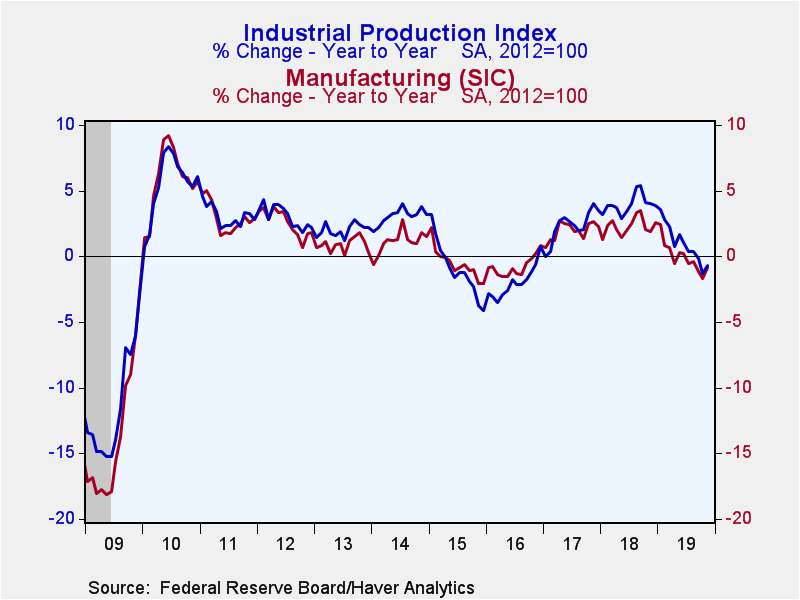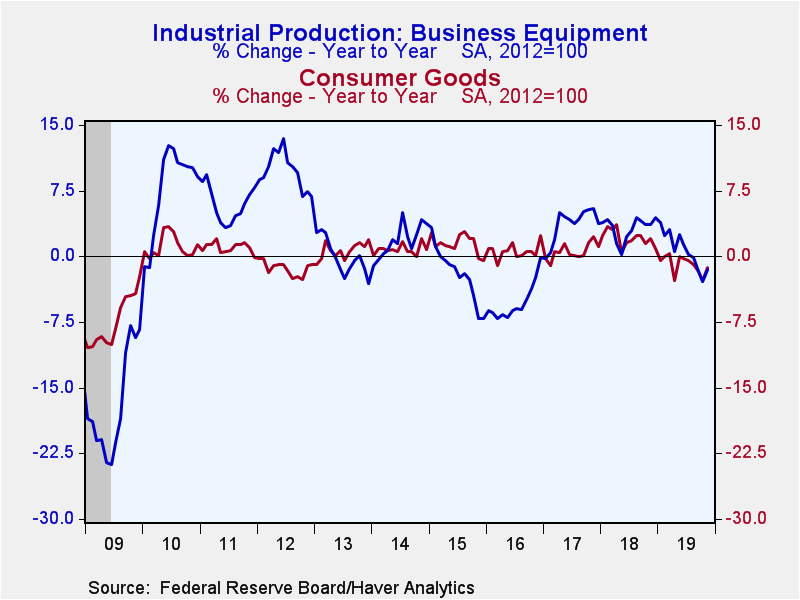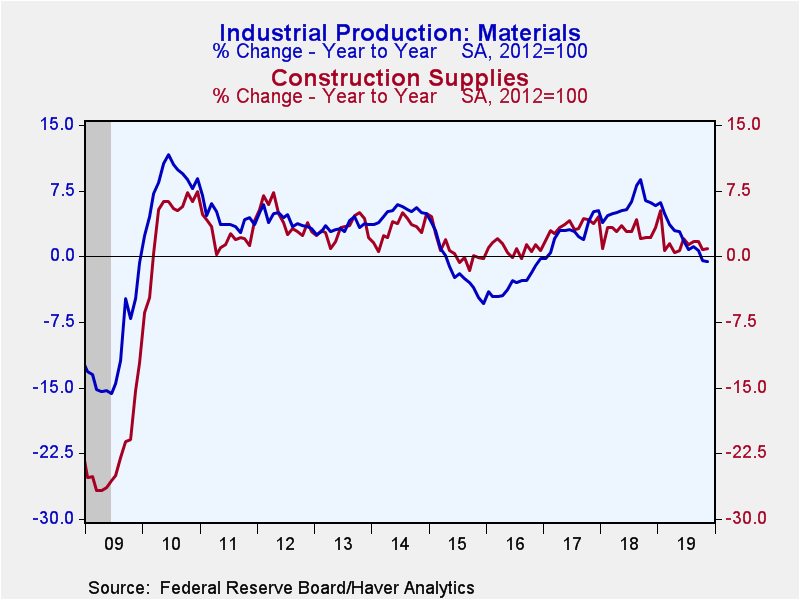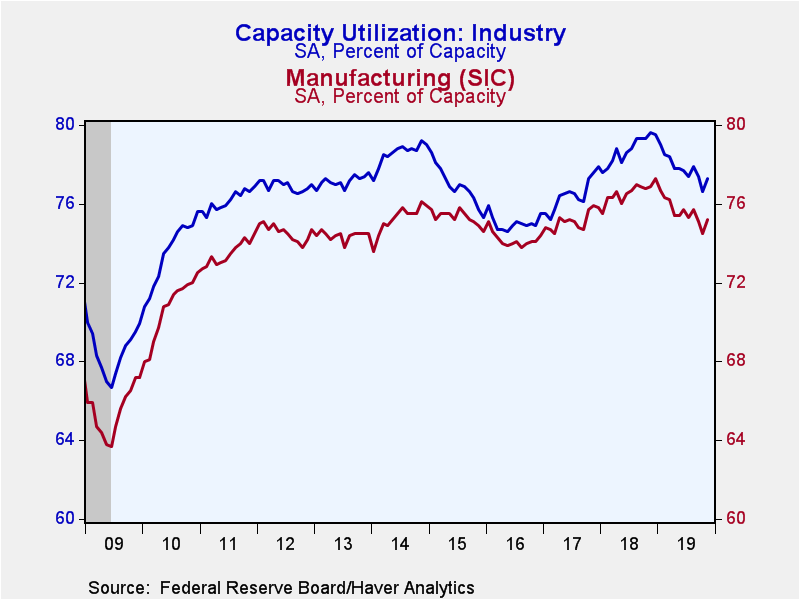 Global| Dec 17 2019
Global| Dec 17 2019U.S. Industrial Production Rebounded in November
by:Sandy Batten
|in:Economy in Brief
Summary
Industrial production rebounded in November, rising 1.1% m/m (-0.8% y/y) after having fallen a downwardly revised 0.9% m/m in October and 0.4% m/m in September. The Action Economics Forecast Survey had looked for a 0.8% m/m rise. [...]
Industrial production rebounded in November, rising 1.1% m/m (-0.8% y/y) after having fallen a downwardly revised 0.9% m/m in October and 0.4% m/m in September. The Action Economics Forecast Survey had looked for a 0.8% m/m rise. Manufacturing output also rose 1.1% m/m (-0.9% y/y) in November after declines in both October and September with cooler weather boosting utilities output 2.9% m/m (-4.1% y/y) after a 2.4% m/m decline in October. Mining output fell 0.2% m/m (+2.0% y/y) in November for its fourth decline in the past five months.
The November rebound in overall production was led by the revival of motor vehicle production as the strike at General Motors was resolved. Motor vehicle production jumped up 20.2% y/y in November after declines of 9.3% m/m in October and 8.8% m/m in September. But even excluding the rebound in motor vehicle output, other production was stronger in November. Manufacturing output excluding motor vehicles rose 0.3% m/m after having declined 0.3% m/m in both October and September.
Output of final products surged 1.8% m/m after a 0.8% m/m decline in October and a 0.7% m/m drop in September. Consumer goods production rose even more, increasing 2.1% m/m in November, more than offsetting the 0.8% m/m decline in October and the 0.6% m/m drop in September. Business equipment output was also strong, rising 1.7% m/m in November following monthly declines in both October and September. Construction supplies production also rose in November, but only 0.2% m/m, falling far short of offsetting declines in both October and September. Materials production rose 0.7% m/m in November with production of both energy and nonenergy materials rebounding.
In the special aggregate groupings, high-tech production continued to climb, rising 1.7% m/m in November, led by a 2.6% m/m jump in the production of computers and peripheral equipment. Factory output excluding high-tech production rose a solid 1.1% m/m in November while production excluding high-tech and motor vehicles increased a more modest 0.2% m/m but this rise came after declines in both October and September.
The total industry capacity utilization rate increased more than expected to 77.3%, its first increase in three months, from 76.6%. It has been trending down since later 2018. The October reading was the lowest in two years. The factory sector utilization rate also rose in November, to 75.2% from 74.5%, which was the lowest reading since March 2017.
Industrial production and capacity data are included in Haver's USECON database. Additional detail on production and capacity can be found in the IP database. The expectations figures come from the AS1REPNA database.
| Industrial Production (SA, % Change) | Nov | Oct | Sep | Nov Y/Y | 2018 | 2017 | 2016 |
|---|---|---|---|---|---|---|---|
| Total Output | 1.1 | -0.9 | -0.4 | -0.8 | 3.9 | 2.3 | -2.0 |
| Manufacturing | 1.1 | -0.7 | -0.7 | -0.9 | 2.3 | 2.0 | -0.8 |
| Consumer Goods | 2.1 | -0.8 | -0.6 | -1.3 | 2.1 | 0.5 | 0.6 |
| Business Equipment | 1.7 | -0.8 | -1.2 | -1.5 | 3.2 | 3.6 | -5.3 |
| Construction Supplies | 0.2 | -0.5 | -0.3 | 0.9 | 2.8 | 3.5 | 0.9 |
| Materials | 0.7 | -1.1 | -0.3 | -0.6 | 5.9 | 2.7 | -3.0 |
| Utilities | 2.9 | -2.4 | 1.4 | -4.1 | 4.4 | -0.8 | -0.4 |
| Mining | -0.2 | -0.8 | -0.3 | 2.0 | 12.4 | 7.4 | -9.9 |
| Capacity Utilization (%) | 77.3 | 76.6 | 77.4 | 79.6 | 78.7 | 76.5 | 75.0 |
| Manufacturing | 75.2 | 74.5 | 75.1 | 76.9 | 76.6 | 75.1 | 74.2 |
Sandy Batten
AuthorMore in Author Profile »Sandy Batten has more than 30 years of experience analyzing industrial economies and financial markets and a wide range of experience across the financial services sector, government, and academia. Before joining Haver Analytics, Sandy was a Vice President and Senior Economist at Citibank; Senior Credit Market Analyst at CDC Investment Management, Managing Director at Bear Stearns, and Executive Director at JPMorgan. In 2008, Sandy was named the most accurate US forecaster by the National Association for Business Economics. He is a member of the New York Forecasters Club, NABE, and the American Economic Association. Prior to his time in the financial services sector, Sandy was a Research Officer at the Federal Reserve Bank of St. Louis, Senior Staff Economist on the President’s Council of Economic Advisors, Deputy Assistant Secretary for Economic Policy at the US Treasury, and Economist at the International Monetary Fund. Sandy has taught economics at St. Louis University, Denison University, and Muskingun College. He has published numerous peer-reviewed articles in a wide range of academic publications. He has a B.A. in economics from the University of Richmond and a M.A. and Ph.D. in economics from The Ohio State University.










